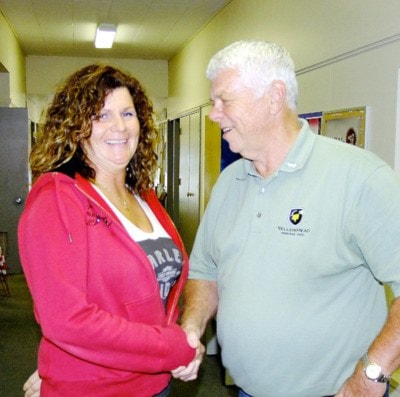Direct jobs at the proposed Harper Creek copper mine would be sourced locally much as possible.
That seemed to be the most important message to local residents being delivered during an open house last Wednesday at the North Thompson Resource Center.
Total attendance was hard to judge as people kept coming and going during the eight-hour long event, but it appeared at least 60 local residents took part.
The event included presentations by Yellowhead Mining CEO Ian Smith and other company representatives, as well as talks by Gerry Hamblin and Alanya Smith of the B.C. Environmental Assessment Office and Linda Sullivan of the Canadian Environmental Assessment Agency.
“We hope to source our workforce from Clearwater and area,” Smith told those present. “We hope a lot of people who live in the Valley chose to work for us.”
Constructing the mine would create up to 500 jobs, mostly in skilled trades. Once the mine became operational about 400 jobs would be created. Most of these, while requiring some training, would be accessible to many local residents.
Another 1,200 indirect jobs (3x multiplier) would be created regionally and across the province.
The proposed Harper Creek mine would be located about 10 km southeast of Clearwater.
With a production of 70,000 tonnes of ore a day and an expected lifetime of 22 years, the mine would be bigger than Gibraltar but half the size of Highland Valley.
It would be primarily a copper mine, Smith said, with that metal paying for 95 per cent of the economics. Gold and silver would be by-products, but over the life of the mine would add significant amounts of income.
Smith estimated the capital cost of constructing the mine at $760 million.
One question asked was how adequate water would be provided for the mine and processing plant, which would be located along the top of a ridge. A significant factor in the timeline for developing the mine would be making a dam for the tailings pond, Smith said.
This would have to collect water for two spring runoffs in order to have enough on hand for mill startup. Once the mill gets going it would be a closed system and only small amounts of water would be needed, probably from wells near the operation.
Another question asked was about acid rock drainage (ARD). This can be a problem when sulphide ores are exposed to air and oxidize, Smith explained. When they then dissolve in water they become acidic. Pyrite is the worst offender.
The best way to prevent ARD is to cover the ore after processing with water and fill, he said.
“If not planned for, it can be a huge problem,” said the Yellowhead CEO.
Gerry Hamblin and Alanya Smith of the B.C. Environmental Assessment Office and Linda Sullivan of the Canadian Environmental Assessment Agency explained how the provincial and federal environmental assessment processes work.
The two processes work in parallel and try to complement each other, they said.
The provincial process is presently trying to determine the information requirements for the Harper Creek environmental application. Public comments can be sent in any time but only will be posted to the Web if received during the next month.
The time for initial public comment under the federal process closed at the end of May. An invitation for interested individuals and groups to apply for up to $50,000 in funding to take part in the process also closed, said Sullivan. However, she said possibly applications could be accepted after the deadline.
